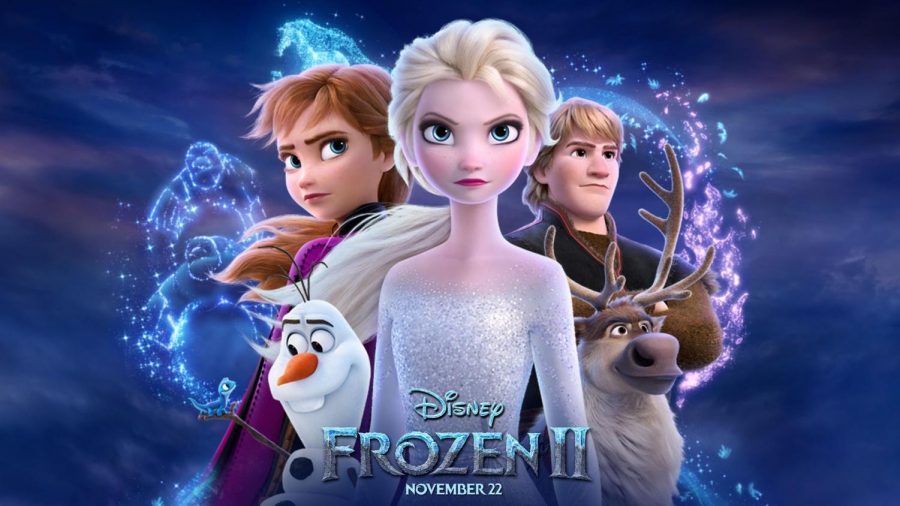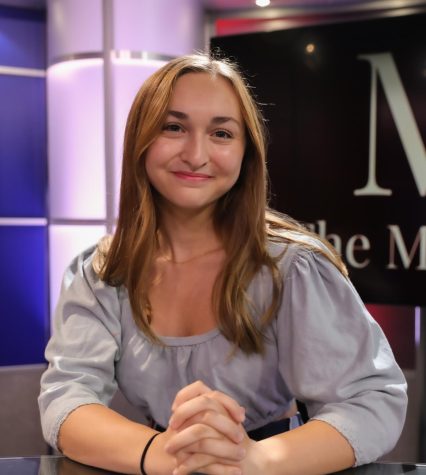Review: “Frozen 2” slips on thin ice with confusing plot points and loss of authenticity
December 10, 2019
Across the country, families reunited for Thanksgiving, flocking to local theaters to watch the long-awaited “Frozen 2.” But many may have been left utterly confused by the film’s DreamWorks-like qualities.
I, like many others, was left staring at my ticket by the end of the movie. I didn’t realize “Frozen 2” was actually Disney’s rendition of “How to Train Your Dragon,” but instead of vikings taming dragons, Elsa, played by Idina Menzel, tames the wispy spirits that keep her up at night.
In 2013, the royal sisters of Arendelle were estranged inside the castle walls as their parents’ ship went down in the Dark Sea. Elsa, the uncontrollable ice princess, was prematurely coronated as the Queen of Arendelle and her inner-darkness and power continued to grow. Out of sheer recklessness, Elsa abandoned her kingdom for isolation in the depths of the nordic mountain. Anna, voiced by Kristen Bell, her curious, bright-eyed little sister, followed her into winter’s abyss, and befriended snowman Olaf, voiced by Josh Gad, mountaineer Kristoff, voiced by Jonathan Groff, and his reindeer Sven. In the end, Elsa’s fears and the eternal winter was thawed by her love, not for a man she met in a day, but for her sister.
The movie’s break with traditional princess movie standards inspired progressive fan-fiction: the most prominent being Elsa as the first openly gay Disney queen.
But as of “Frozen 2,” Elsa’s sexuality hasn’t changed (although it’s open for interpretation). In the six years since the original movie, Elsa remains as single as ever and continues to explore individualism and self-love.
Instead of confirming Elsa as the first openly-gay lead in a Disney movie, they pushed the inclusion envelope by including the Northuldra tribe, which was inspired by the Sámi, a tribe that is indigenous to Scandinavia. This was included after backlash of the original “Frozen” whitewashing and cultural appropriating the Sámi people.
According to CBC News, Disney worked alongside Sámi people during the film and signed a formal agreement with the tribe’s Scandinavian parliament to make sure the group’s rights are protected. Their actions of consulting with the group and including them in the film is a step in the right direction for the future of inclusion in film. However, by making Anna and Elsa half-indigenous via their mother’s blood, it seems like Disney was trying to cover their tracks for the original movie.
Their tie to Northuldra is discovered when a pesky mystical chant that has made Elsa restless for months has led her and, of course, her friends to the Enchanted Forest. Since their grandfather’s reign, they found that the forest has been confined living quarters of the tribe and knights of Arendelle, who were displaced by the dam protecting Arendelle. In a quest to set things right, Elsa sets out “Into the Unknown” and strangely befriends creatures that tried to kill her such as a spunky fire lizard and an eloquent water/ice horse.
Visuals by far took the crown as the most astonishing aspect of the movie. For a Disney movie, the visuals were eerie and frightening. Fall was illustrated with an unsettling briskness and the animation of Elsa’s unexplainable underwater fight/convening with the Ice Horse seemed like uncharted territory for Disney — impressive, but different. Sure, magic is an integral part of the Disney movie experience, but not to that level of mysticism. Elsa’s intricate ice technique along with the use of random creatures made me feel like I was watching either a DreamWorks movie or a game of “Super Smash Brothers” with a plot. For lack of better phrasing it was strange, hard to follow yet visually appealing.
The change in animation technique was not the only off-key aspect of the film: Anna and Elsa, perhaps older and wiser, were vastly different. Anna especially has transformed from her fun, adventurous self to an apprehensive, quick-to-judge worrywart who questions everyone’s intentions, even long-term boyfriend Kristoff’s. I get that she is disillusioned from the events of the past, but come on, Jennifer Lee can write her better dialogue than “Elsa, are you ok?” and the occasional whining.
The new Elsa, on the other hand, has become quite a likable, zen queen. Six years has done her wonders for self-acceptance and learning to control her powers. However, her lack of inner-anger and recklessness has taken a toll on the movie’s suspense. Elsa is stagnant from beginning to end and never has a self-revelation — which, by the way, is the purpose of a movie.
As for the other characters, their development is also relatively weak. Kristoff is simply just there. The whole movie he’s plotting his proposal to Anna while he’s separated from her as she finds her sister. His breakthrough was probably “Lost in the Woods” where he takes on a George Michael persona, and sings to a bunch of reindeer about how he misses Anna.
Olaf was as funny as the first movie. His “In Summer”-like song, “When I’m Older,” along with his random fun facts, kept the movie going when scenes were rather dry.
With all of this said, I can’t help but wonder why? Why did they make this movie in the first place?
Sure, it was visually pleasing and funny at times, but there was absolutely no purpose for anything. The development of the original characters and their new songs was weak, the plot was ambiguous and the graphics while appealing was without purpose.
It’s hard to not think that Disney only made this movie to seem forward-thinking and retroactively cover their mistakes from the first movie. Even if this was the objective, why do Elsa and Anna have to be part indigenous? It seems forced and I’m sure it comes across offensive to some.
In conclusion, “Frozen 2” is a fun movie for young kids who can only appreciate flying colors and funny-looking characters. For those that thoroughly enjoyed the first movie, I would abstain from seeing this one.









